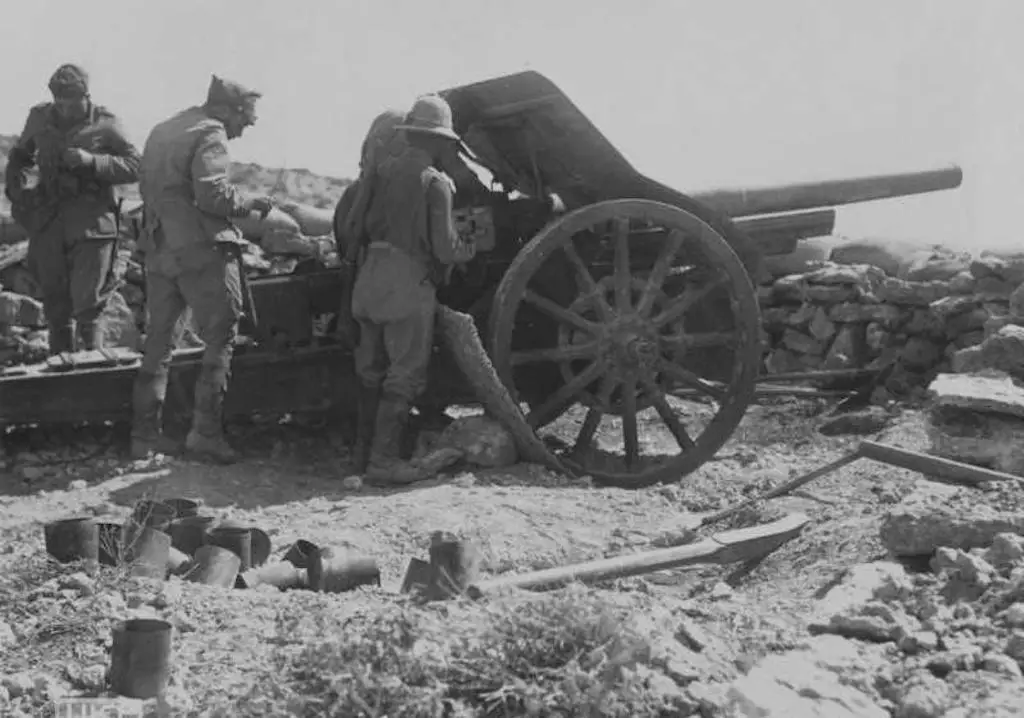Background on the Cannone da 105/28 Modello 1913
The Cannone da 105/28 modello 1913 is the Italian designation for the French Canon de 105 mle 1913 Schneider. As background, in the first decade of the 20th century, the French company Schneider collaborated with the Russian Putilov armaments factory as part of a deliberate plan of commercial expansion. The infusion of French capital was a decided advantage for the Russian company.
The Russian military tasked Schneifer to develop a cannon for Russian 107 mm rounds. Schneider developed a modified version of the 107 mm cannon and offered it to the French army as a 105 mm cannon. France seemed uninterested in it. The French believed a 75 mm was all it required and there was no need for heavier weapons. Eventually, the Schneider sales approach triumphed and the modified Russian design was adopted by the French army as the Canon de 105 mle 1913 Schneider, better known as the L 13 S.

Cannone da 105/28 (Luce)
L 13 S Hit the World Market
The events of 1914 rammed home to the French that the 75 mm was not capable of providing all the artillery fire support required, and heavier guns would be necessary. Thus the L 13 S was placed in higher priority bracket and large numbers began to roll off the Schneider production lines.
Between 1914 and 1918 the L 13 S provided sterling service. It was a beautiful gun with a long barrel and conventional box trial that provided enough elevation for the 15.74 kg shell to reach a range of 12,000 meters. The L 13 S became a French export after 1918 and sold or handed on to numerous armies under French influence. These nations included Belgium, Poland, and Yugoslavia.
But it was in Italy that the L 13 S achieved its main market penetration. There the L 13 S became the Cannone da 105/28 Modello 1913 and remained with Italian forces until 1943.
L 13 S Used for Atlantic Wall
After 1940 the Germans found that the L 13 S was still a viable weapon and out of the 854 still in French service in May 1940, they captured many that were still intact. Large numbers were handed over to various occupation units but it was not until 1941 that a real use was found for the bulk of the booty. When the Atlantic Wall was ready to be armed, the L 13 S was decided upon as one of the primary weapons to be used. There were enough on hand to become a standard weapon, and there were stockpiles of ammunition ready for use. Thus the L 13 S became the German 10.5-cm K 331(f). Germany designated Ex- Belgian guns as 10.5-cm K 333(b).
The Germans took the guns off their carriages and mounted them on special turntables and protected them by curved or armored shields. These were placed in bunkers all along the French and other coasts. As a beach defense gun the L 13 S was more than suitable, and the bunkers were difficult for any attacking force to overcome. Not all of the guns in these bunkers were ex-French and Belgian guns, but included ex-Yugoslav (10.5-cm K 338(j)) and ex-Polish (10.5-cm K 13 (p)) and ex-Italian guns (10.5-cm K 338(i)) as well.
Cannone da 105/28 Specifications
| Model | Cannone da 105/28 |
|---|---|
| Caliber | 4.134" (105 mm) |
| Length | 117.6" (2.987 m) |
| Traveling Weight | 5,843 lbs (2,650 kg) |
| Firing Weight | 5,070 lbs (2,300 kg) |
| Muzzle Velocity | 1,804 ft/sec (550 mps) |
| Maximum Range | 13,130 yards (12,000 m) |
| Shell Weight | 34.7lbs (15.74kg) for French guns and 35.8lbs (16.24kg) for Italian guns |
| Traverse | 6º |
| Elevation | -5º to +37º |
Additional resources:
The Encyclopedia of Weapons: From World War II to the Present Day
Twentieth-Century Artillery: 300 of the World’s Greatest Artillery Pieces
